Introduction
Are you struggling to choose between SmythOS and Adala as your preferred AI platform? Making an informed decision is crucial, and in this article, we’ll provide you with a clear comparison of the features and capabilities of both platforms. Whether you’re a developer, business owner, or part of an innovation team, understanding the unique offerings of SmythOS and Adala is essential. This comprehensive analysis will equip you with the knowledge needed to make the right choice for your AI needs.
SmythOS is an adaptable and comprehensive AI platform that stands out for its advanced AI integration capabilities, scalable infrastructure, and broad spectrum of deployment options. It offers hosted agents, environments for both development and production, a visual builder for workflows without coding, and supports memory and context for continuous learning. Its advanced debugging tools and logging capabilities ensure explainability and transparency in AI decision-making processes.
On the other hand, Adala offers a distinct focus on semi-autonomous lang language model agents, emphasizing scalability, responsiveness, and adaptability across various domains. It enables the creation and simultaneous operation of multiple agents, promoting collaboration and knowledge sharing. Adala also provides a no-code editor with a drag-and-drop interface, making it accessible to users with minimal coding experience.
With their unique features and capabilities, SmythOS and Adala cater to a diverse audience including enterprises, developers, innovation and R&D teams, customer service and support departments, IT administrators, and marketing and web management teams. Whether you require scalable AI solutions, flexible and powerful AI development tools, or AI-driven customer engagement solutions, SmythOS and Adala have you covered.
An Insight into SmythOS: Target Audience, Unique Features, and Vision


SmythOS is a powerful platform for creating and deploying AI agents. But what does it really do? And who uses it? Let’s delve into its offering, target audience, unique features, and the vision behind it.
SmythOS is designed to provide an easy way to build AI agents. Have you ever played with building blocks? Think of it as the ultimate set of building blocks for AI. You can easily create AI agents that can chat, work in apps, and even gather information on the internet. Even if you are not a programmer, it’s not a problem. SmythOS has a no-code editor. This means you don’t need to understand computer languages to create AI agents. Instead, you can use visual ‘drag and drop’ tools.
These AI agents learn from experience. Would you remember something better if you had seen it once or many times? Obviously, many times. That’s exactly what these AI agents do using a memory feature called DataLake.
It may also seem obvious, but these AI agents don’t just work by themselves. They team up with other tools and platforms, like Zapier, to extend their abilities.
Feeling overwhelmed? Don’t worry! An important part of the SmythOS offering is transparency. It offers tools to understand what’s going on inside the AI agents. Almost like being able to ask a friend ‘why did you do that?’
SmythOS aims to be a solution for a wide range of users. This includes large corporations, programmers, research teams, customer service departments and IT administrators. This platform can cater to their various needs with features that are flexible, advanced and efficient.
Finally, let’s talk about the vision of SmythOS. They imagine a world where AI is not a fancy buzzword but a practical tool for various jobs. It’s made easy to access and use for everyone. Their shipped products focus on using AI to make sense of information rather than creating new information, while also connecting to other sources if needed. Imagine a world where information and tasks are processed, categorized, and scheduled by AI, which is exactly what SmythOS is aiming for.
An Overview of Adala


Adala is a unique tool designed for those interested in creating sophisticated AI solutions. Notably, it caters to AI Engineers and Machine Learning Researchers, offering an environment that enables users to experiment with complex problems and advance their work.
At its core, Adala’s offering includes a framework that prioritizes data processing tasks. These include data labeling, classification, and summarization. Although it doesn’t seem to handle other data types like images or audio, it does offer a user-friendly interface through Python notebooks.
In terms of unique features, Adala allows configuration of specific constraints and outputs, aligning with the concept of constrained alignment. Although there is no mention of specific security protocols, it integrates well with models like ChatGPT.
Adala’s vision is to increase efficiency and reduce costs associated with data labeling, all while maintaining high quality through human guidance. However, currently, there appear to be no shipped products or tools that specifically fall under Adala’s innovation.
While there are areas of improvement, Adala does hold significant promise for the target audience, providing a unique tool that combines AI with human input for improved and adaptable results. This is a noteworthy aspect of Adala’s offering.
SmythOS vs Adala: A Detailed Feature Comparison
When it comes to choosing the right platform for your needs, understanding the features is crucial. This guide will compare the features of SmythOS and Adala, allowing you to make an informed decision.
| Features | SmythOS | Adala |
|---|---|---|
| Hosted Agents (Dev, Production) | ✅ | ❌ |
| Environments (Dev, Production) | ✅ | ❌ |
| Visual Builder | ✅ | ❌ |
| No-Code Editor | ✅ | ❌ |
| Memory & Context | ✅ | ✅ |
| Autonomous Agents | ✅ | ❌ |
| Explainability and Transparency | ✅ | ❌ |
| Debug Mode | ✅ | ❌ |
| Multimodal | ✅ | ❌ |
| Problem-Solving Capabilities | ✅ | ✅ |
The differences between these two platforms are extensive. SmythOS offers a broader range of features, such as the Visual Builder and Autonomous Agents, which are not available in Adala. This suggests that SmythOS may be more suited to users who need a comprehensive, user-friendly platform. The Debug Mode in SmythOS also provides more transparency, making it easier to identify and fix issues. However, Adala also shines in some areas like Memory & Context and Problem-Solving Capabilities, which they share with SmythOS. This implies that Adala may be a strong choice for users who prioritize these specific aspects.
It’s important to consider what each platform can offer in terms of advancing your objectives. Both offer distinct benefits that could prove useful depending on your needs. Use this comparison as a stepping stone to delve deeper into what SmythOS and Adala have to offer and select the best fit for you.
Who is SmythOS and Adala for?
SmythOS and Adala are designed to cater to a diverse audience, from technical experts to business users in need of AI-driven solutions. Their features and applications aim to meet the needs of various industries and users, with a focus on enterprises and agencies looking to integrate advanced AI capabilities into their operations.
End Users and Target Audience:
- Enterprises and Businesses: Large-scale organizations and businesses that require scalable AI solutions for processing large volumes of data, automating tasks, and enhancing customer interactions. The platform’s data lake component, API integration, and scalability features are particularly beneficial for these entities.
- Developers and AI Engineers: Technical professionals who are looking to build, deploy, and manage AI agents with ease. SmythOS’s integration with foundational models like GPT, drag-and-drop workflow builders, and the ability to deploy AI agents in various formats cater to developers who need a flexible and robust platform for AI development.
- Innovation and R&D Teams: Teams focused on research and development in AI and machine learning can leverage SmythOS for its capability to integrate with advanced AI models and for its inference-focused platform, allowing for rapid prototyping and deployment of AI agents.
- Customer Service and Support Departments: Departments that require AI-driven solutions for customer engagement, such as chatbots and other interactive tools. SmythOS’s ability to deploy AI as interactive chatbots on websites makes it a suitable choice for enhancing customer service.
- IT and System Administrators: Professionals responsible for maintaining and optimizing IT infrastructure can benefit from the platform’s emphasis on scalability and efficient resource allocation, ensuring that AI solutions are cost-effective and align with the organization’s usage patterns.
- Marketing and Web Management Teams: Teams managing websites and online content can utilize SmythOS’s site and URL crawling capabilities for better understanding and interacting with web content, which is crucial for digital marketing and online presence.
SmythOS and Adala offer flexibility, ease of use, advanced AI capabilities, scalability, and efficiency to cater to the needs of their intended audience. The platforms provide comprehensive and flexible AI integration capabilities, scalable infrastructure, and a broad spectrum of deployment options, all aimed at enhancing the functionality and accessibility of AI technologies in various sectors.
When comparing SmythOS to other platforms, its standout features such as data lake components, API integration and deployment, AI model integration, scalability, deployment flexibility, scheduling capabilities, and site and URL crawling make it a preferred choice for users looking for advanced AI functionalities and an adaptable AI solution.
Adala, on the other hand, is designed primarily for AI engineers and machine learning researchers. It provides a platform for building production-level agent systems by abstracting low-level machine learning to the framework and large language models (LLMs). Adala offers an environment for experimenting with complex problem decomposition and causal reasoning, making it suitable for researchers exploring new methodologies and techniques in AI and machine learning.
Conclusion
After a thorough comparison between SmythOS and Adala, it is clear that SmythOS emerges as the preferred choice. SmythOS offers a comprehensive and flexible integration of AI agents into various environments and diverse applications. Its advantages over Adala include:
- Adaptable AI Integration: SmythOS stands out for its ability to integrate and utilize AI agents in different environments and for diverse applications.
- Scalable Infrastructure: SmythOS provides a scalable infrastructure that meets the needs of large-scale organizations and businesses, allowing for processing large volumes of data and automating tasks.
- Broad Spectrum of Deployment Options: SmythOS offers a wide range of deployment options, such as chatbots, apps, APIs, or plugins, providing flexibility to cater to different requirements.
- No-Code Editor and Visual Builder: The platform supports a visual builder for workflows, allowing users to create complex workflows without coding. This feature is particularly beneficial for users with minimal coding experience.
- Autonomous Agents: SmythOS enables the creation of autonomous AI agents that can continuously operate, adaptively learn from their environment, and develop their capabilities progressively.
- Explainability and Transparency: SmythOS provides advanced debugging tools and logging capabilities for understanding the decision-making processes of AI agents.
- Zapier Integration: SmythOS supports integration with Zapier, extending its operational domain across various platforms.
- Compatibility with APIs and RPA: SmythOS integrates natively with various APIs and supports a wide range of data sources, suggesting compatibility with diverse APIs and RPA tools.
- Classifiers and Logic Gates: SmythOS includes components like classifiers and logic gates, enabling data categorization and complex logic.
- Flexibility and Ease of Use: With its visual workflow builders and drag-and-drop interfaces, SmythOS caters to users who require ease of use in AI deployment.
- Advanced AI Capabilities: Integration with cutting-edge AI models and APIs meets the needs of users who are looking for advanced AI functionalities.
- Scalability and Efficiency: SmythOS operates on a SaaS usage-based model, ensuring cost-effectiveness and efficient resource allocation, making it suitable for large organizations and businesses.
SmythOS is designed for a diverse audience, from technical experts in AI to business users in need of AI-driven solutions. Its features cater to a wide range of needs, from development and deployment flexibility to advanced AI capabilities and efficient resource management.
Last updated:
Disclaimer: The information presented in this article is for general informational purposes only and is provided as is. While we strive to keep the content up-to-date and accurate, we make no representations or warranties of any kind, express or implied, about the completeness, accuracy, reliability, suitability, or availability of the information contained in this article.
Any reliance you place on such information is strictly at your own risk. We reserve the right to make additions, deletions, or modifications to the contents of this article at any time without prior notice.
In no event will we be liable for any loss or damage including without limitation, indirect or consequential loss or damage, or any loss or damage whatsoever arising from loss of data, profits, or any other loss not specified herein arising out of, or in connection with, the use of this article.
Despite our best efforts, this article may contain oversights, errors, or omissions. If you notice any inaccuracies or have concerns about the content, please report them through our content feedback form. Your input helps us maintain the quality and reliability of our information.
Alexander De Ridder
Co-Founder, Visionary, and CTO at SmythOS. Alexander crafts AI tools and solutions for enterprises and the web. He is a smart creative, a builder of amazing things. He loves to study “how” and “why” humans and AI make decisions.
Explore All Comparison Articles
Decisions vs. Sola: AI Workflow Automation Showdown
AI-powered workflow automation platforms revolutionize how businesses streamline operations and boost productivity. This comparison explores Decisions vs. Sola, and SmythOS,…
DeepOpinion vs. Sola: Comparing AI Automation Platforms
AI-powered automation platforms revolutionize business operations, but choosing the right solution can be challenging. This comparison of DeepOpinion vs. Sola,…
DevGPT vs. Sola: AI-Powered Development Tools Compared
AI-powered development tools revolutionize software creation, offering unprecedented efficiency and capabilities. This comprehensive review compares DevGPT vs. Sola, and SmythOS,…
Fine AI vs. Sola: Comparing AI Automation Tools
AI-powered automation transforms software development and business workflows, offering unprecedented efficiency and innovation. Fine AI vs. Sola present distinct approaches…
FlowiseAI vs. Sola: Comparing AI Automation Platforms
AI-powered automation revolutionizes business operations, driving efficiency and innovation across industries. FlowiseAI vs. Sola offer distinct approaches to harness this…
Gooey AI vs. Sola: AI-Powered Automation Platforms Compared
AI-powered automation platforms revolutionize how businesses streamline operations and enhance productivity. This comparison delves into Gooey AI vs. Sola, two…

